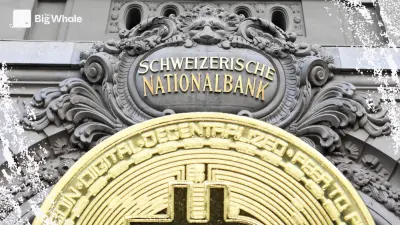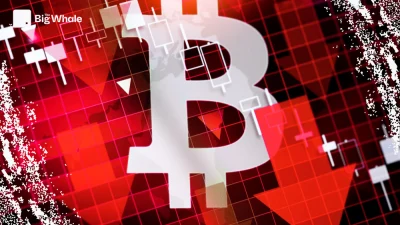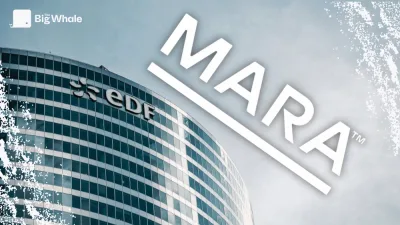TBW - Ethereum: what's the problem?

Ethereum is at a crossroads. While its network has never been so active - between the rise of L2s, widespread staking and gradual institutional adoption - its token, meanwhile, is stagnating or falling back, in stark contrast to the euphoria surrounding Bitcoin and certain new crypto narratives.
Why such a dichotomy? What signals are the market, investors and the ecosystem sending?
Investigating an increasingly glaring paradox.
Despite flourishing activity, ETH is one of the worst-performing major assets
Since the start of 2024, Ethereum (ETH) has struggled to keep pace with the crypto market. While Bitcoin (BTC) is posting a spectacular +30% surge and Solana (SOL) is up -13%, the native asset of the leading smart contract network is recording a notable underperformance: -50% over the same period.
A stagnation that raises questions, even though activity on the network remains particularly buoyant.

Because despite this low price, the Ethereum ecosystem is continuing to strengthen on a fundamental level. Decentralised finance (DeFi), non-fungible tokens (NFT), staking and even scalability solutions such as rollups are evidence of sustained activity and growing adoption.
Since the switch to proof of stake in 2022, followed by the introduction of liquid staking, the network has continued to transform. One of the most visible markers of this evolution is the rise of Layer 2 solutions, which increase transaction processing capacity tenfold while relying on Ethereum's security.
In December 2024, the total locked value (TVL) on L2s reached an all-time high, before falling back amid an overall market downturn
-21.5% over 1 year when the value expressed in dollars :

But +51% when the value is expressed in ETH:

Today, more than 60 Layer 2 rollups are active - a figure that is constantly rising. The number of unique addresses interacting with the Ethereum ecosystem each week via these L2s has grown steadily since 2023, a sign of structural adoption.
Another indicator of this momentum: staking continues to grow. In April 2025, more than 28% of the total ETH offer was now staked, compared with around 15% at the same time in 2023. Lido, the main liquid staking protocol, saw its deposits jump at the start of the year, illustrating a growing interest in passive income on Ethereum.
Restaking - this new layer of security offered in particular by EigenLayer - although in a consolidation phase, made a strong mark in the first half of 2024 through its ability to attract capital and redefine validator incentives.
On the applications side, some platforms are hitting record highs. Aave recorded a record TVL in December 2024, while Uniswap remains the undisputed sector leader with more than 40% of the volumes traded on DEXs in the EVM universe, according to data from Dune Analytics.
The Bitcoin narrative has monopolised investor attention
For several months, the crypto scene has been largely dominated by a single player: Bitcoin. The long-awaited approval of spot ETFs in the US in January 2024 triggered a massive influx of institutional capital into the leading crypto by capitalisation. By mid-April 2025, these financial vehicles had accumulated to $100 billion.

Another element that reinforces the story is the US government's strategic stance towards Bitcoin. Washington, which holds several hundred thousand BTC from court seizures, recently announced that it had no intention of liquidating these assets, considering them to be strategic reserves. This is a strong signal, which puts Bitcoin on a quasi-sovereign footing, even if no active purchasing policy has been formalised.
In the shadow of this rise in power, Ethereum is struggling to attract comparable attention. The recent approval of spot ETFs on ETH - despite being seen as a major breakthrough - has not produced the same effect as for Bitcoin. In mid-April 2025, ETH ETFs as a whole were worth $6 billion, a respectable level but nowhere near the volumes drained by their BTC equivalent.

This asymmetry is reflected in a key indicator: Bitcoin's dominance, which measures the share of BTC in the total capitalisation of the crypto market, reached 63% in mid-April. You have to go back to March 2021 to find such a level. It enshrines the pre-eminence of BTC in investors' imaginations, to the detriment of other digital assets.

Solana, Avalanche, Ethereum... All are struggling to exist in the media in the face of the Bitcoin narrative machine, now boosted by institutional flows, monetary scarcity and growing recognition by states.
Solana and Base came out on top during the memecoin and AI agent wave of 2024, but these narratives mainly reached investors with the highest risk profile.
>> Solana and memecoins: investigating a toxic addiction
An unfavourable macroeconomic context
The macroeconomic environment is also playing a key role in the current dynamics of the cryptocurrency market. The restrictive monetary policy pursued by the major central banks, and the US Federal Reserve in particular, is weighing on risk appetite. Against a backdrop of high interest rates, liquidity is becoming scarcer and investors are favouring assets deemed safer, such as bonds or short-term deposits, to the detriment of more volatile markets such as cryptos.
This trend has become more pronounced in recent months. In March inflation in the US still stood at 2.4%, prompting the Fed to keep its key rate within a range of 4.25% to 4.50%. This decision extends the pause in the expected rate-cutting cycle that began in January 2025. For the markets, this monetary prudence translates into a climate of uncertainty - and therefore a "risk-off" posture: capital is pulling back, speculation is becoming rarer, and flows into digital assets are drying up.
In addition to this economic equation, there is a political dimension. Donald Trump has made repeated statements calling on the Fed to cut rates faster to stimulate the economy. At the same time, his speeches in favour of new customs taxes have rekindled trade tensions, adding a layer of geopolitical uncertainty that is not lost on investors.
In this climate, the riskiest assets - starting with cryptocurrencies - are struggling to regain a sustainable upward momentum. In fact, the contrast is striking: while the crypto market is marking time, gold, the safe haven par excellence in times of economic turbulence, has just hit a new all-time high.
>> Tokenisation: what if Bity offered the best way to invest in gold?
The internal challenges of an ever-changing network
Some of the network's own dynamics also help to blur its legibility and limit its value.
An asset of growing complexity
In contrast to Bitcoin, whose message is crystal clear - a digital store of value, an alternative to gold - Ethereum is distinguished by a more complex ecosystem. Smart contracts, DeFi applications, NFT, Layer 2, staking... so many technological building blocks that form a coherent whole, but difficult to grasp for the general public as well as institutional investors.
This lack of simplicity detracts from the clarity of the narrative. Where Bitcoin embodies "digital gold", Ethereum has to constantly explain its usefulness, uses and technical developments. The result: slower adoption in certain institutional circles, where effective storytelling plays an essential role.
An ecosystem shattered by the move to rollup-centric
With the adoption of a so-called rollup-centric model, Ethereum has gradually shifted much of its activity to layer 2 solutions such as Optimism, Arbitrum, Base and zkSync. These networks enable more transactions to be processed at lower cost, while relying on the security of Ethereum L1. But this transition is leading to increasing fragmentation of the ecosystem.
Today, more than 50 L2s are in operation or under development. While this diversity testifies to the constant innovation of the network, it also introduces friction: users have to juggle between several networks, use bridges to transfer their assets, and deal with a sometimes degraded experience. This operational complexity can discourage newcomers and contributes to making on-chain activity less visible. Layer 1 appears to be less active, even as overall Ethereum usage across all layers continues to grow.
>> Ethereum: What is the business model for a layer 2?
L2s that capture value without necessarily redistributing it
Another consequence of this multi-layer architecture: some of the value generated by L2s does not directly benefit Ethereum. The Dencun update, rolled out in March 2024, introduced blobs, a mechanism designed to reduce the transaction costs of rollups. While this innovation has served its purpose, it has also caused the revenue generated by L2s for Ethereum to plummet.
With a record $3.9 million paid by L2s on 5 March 2024, L2s very rarely exceed $50,000 per day.

The case of Base is telling: despite flourishing activity, this L2 only pays back a few tens of thousands of dollars a month to Ethereum, a derisory sum compared to the volumes processed.
In March 20235, Base recorded $4.6 million in revenue and paid $107,000 to Ethereum.

The general drop in fees makes the model more efficient, but deprives Ethereum of a significant source of revenue. This raises a central question: how can we reconcile the decentralisation of the network with a fair contribution from L2s to its security and development?
Should Layer 1 fees be lowered further?
The next major evolution of the protocol, the Pectra update scheduled for April 2025, moves in this direction. By increasing the number of available blobs per block, it will further reduce congestion and costs on Layer 1. While this direction may seem excessive in the short term - L2s are already very accessible - it responds to a long-term rationale: to prepare Ethereum for mass adoption, while maintaining its guarantees of security and decentralisation.
Today, blobs are already being used to capacity, which limits the efficiency of rollups. Pectra meets this immediate need for expansion. One question remains: could an inexpensive L1 weaken the incentive to use L2s, created precisely to relieve the main chain? The balance is delicate, but fundamental.
The ambition remains intact: to make Ethereum the universal infrastructure of tomorrow's internet. An ambition based on a bold technological gamble - and a conviction: eventually, adoption and value will converge.
>> Pectra : Everything the next Ethereum update will change
An economic design under strain
Beyond the technical and narrative challenges, some observers are pointing the finger at the limits of Ethereum's economic model. Since the switch to Proof-of-Stake (PoS), the network's economy is now based on a staking mechanism, which is raising more and more questions about its long-term effects.
Staking, a system that favours the richest?
In the current architecture, the more ETH a user stakes, the more they are paid. While this mechanism seems logical on the surface, it tends to accentuate the concentration of rewards to the benefit of the biggest holders - the whales. The latter are thus able to increase their influence over the network, while smaller holders are forced to go through intermediaries, such as centralised platforms or liquid staking pools like Lido. A situation that raises questions of governance and decentralisation.
This observation fuels a fundamental debate: is PoS fundamentally fairer than Proof-of-Work (PoW)? The latter, used by Bitcoin, imposes an entry cost based on hardware and energy investment, whereas PoS is content with initial capital. While PoS is undoubtedly more energy-efficient and better suited to the evolution of the network, it also presents the risk of a form of rent and the gradual centralisation of resources.
An overly financialised value?
Another recurring criticism is the speculative drift surrounding Ethereum. All too often, discussions focus on the price of ETH, its prospects for growth, or its positioning in relation to macroeconomic cycles. This purely financial approach tends to overshadow the essence of the project: Ethereum is not simply an asset to be traded, but a decentralised infrastructure designed to run smart contracts and carry the Web3 economy.
With this in mind, the network's true success is not measured solely by its price, but by its ability to unite developers, attract projects, and serve as the foundation for an autonomous digital economy.
Deflating: blessing or hindrance?
Ethereum's business model also incorporates a rare feature: a burn mechanism that destroys part of the transaction fees, potentially making ETH deflationary. While this enhanced scarcity may appeal to investors, it also poses a fundamental dilemma: to what extent can an asset designed to be used thrive if it becomes too valuable to be spent?
Excessive deflation could curb the everyday use of ETH, slowing the adoption of decentralised applications and harming the on-chain economy. Conversely, moderate inflation keeps a steady flow of tokens in circulation, encouraging activity.
Since The Merge, Ethereum has experienced a period of marked deflation, particularly in 2023. But the trend reversed after the Dencun update in 2024. ETH's annual inflation now hovers around 0.70% to 0.80%, depending on the period. A relatively low level, but one that restores some economic flexibility to the network.

Takeover of the Foundation and future updates
Faced with criticism from part of the community - concerned about the project's strategic direction - the Ethereum Foundation made a discreet but significant U-turn. At the end of 2024, it reviewed its cash management in order to better capitalise on its assets, without resorting to the sale of ETH.
>> Ethereum Foundation: An essential but contested organisation
A strategic and financial shift
Concretely, 45,000 ETH, or around $83 million at the current price, have been invested in DeFi protocols such as Spark, Aave or Compound. The aim is to generate a passive return (estimated at 1.5% a year, or $1.8 million), while supporting the ecosystem and avoiding exerting selling pressure on the market. This financial repositioning reflects a clear desire to guarantee the stability of the Foundation without compromising either its independence or the balance of the network.
At the same time, the emphasis is on institutional adoption. In particular, the Foundation supports Etherealize, an organisation dedicated to bringing Ethereum and the world of traditional finance closer together. The communications strategy has also evolved: social networks, long under-exploited, have become a key lever for boosting the image of a protocol that is often perceived as complex. This is a conscious move to win over traditional investors and strengthen the network's credibility beyond the circle of insiders.
>> Vivek Raman (Etherealize): "We are in the process of raising funds from private players"
Pectra, account abstraction and simplified usage
The next update of the protocol, Pectra, expected in April 2025, should mark a major step forward in user experience. With the introduction of EIP-7702, Ethereum will enable a traditional address to temporarily function as a smart contract. This innovation - better known as account abstraction - aims to make wallets simpler and more intuitive. A major challenge in an ecosystem where technical complexity remains one of the main obstacles to mass adoption.
Although Pectra does not provide an immediate answer to all the problems - in particular the low financial contribution of Layer 2 to Layer 1 - it is part of a long-term approach. While the fees paid per transaction have fallen since the introduction of blobs, the expected explosion in the number of users on L2s could offset this fall. The stakes are clear: attract millions of on-chain users, and ensure that the growth in usage ultimately translates into value creation for Ethereum.
Cap on Fusaka and the era of PeerDAS
The Ethereum roadmap doesn't stop there. After Pectra, the Fusaka update will mark a new stage in optimising scalability. By integrating PeerDAS, a technology designed to improve data management and availability, Ethereum should see its capacity multiplied exponentially. Eventually, the number of blobs could be increased to 128 per slot thanks to 2D sampling - a breakthrough that could enable up to 100,000 transactions per second across all layers.
These developments are fuelling a fundamental debate: which should be prioritised, the ETH price or the technological infrastructure it supports? Because while Layer 2 has undeniably solved a large part of the scalability problems, the value capture mechanisms for ETH are still insufficient. Today, Ethereum usage is growing, but this momentum is not yet reflected in the price of its native asset.



